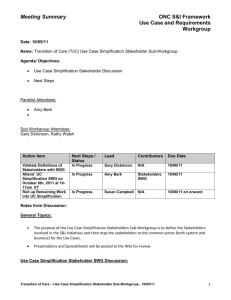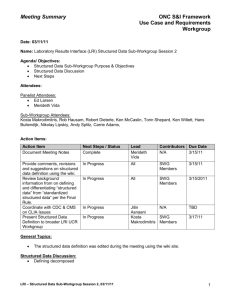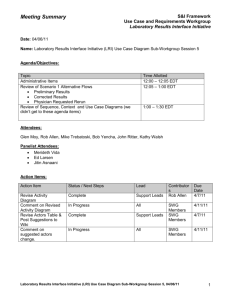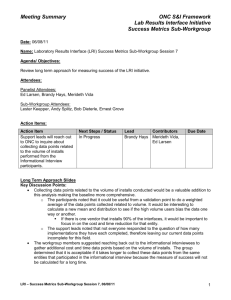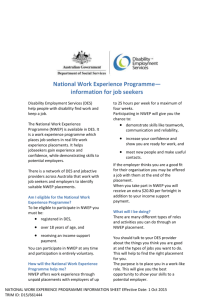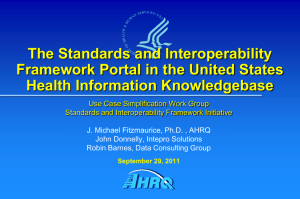Meeting Summary - (S&I) Framework
advertisement
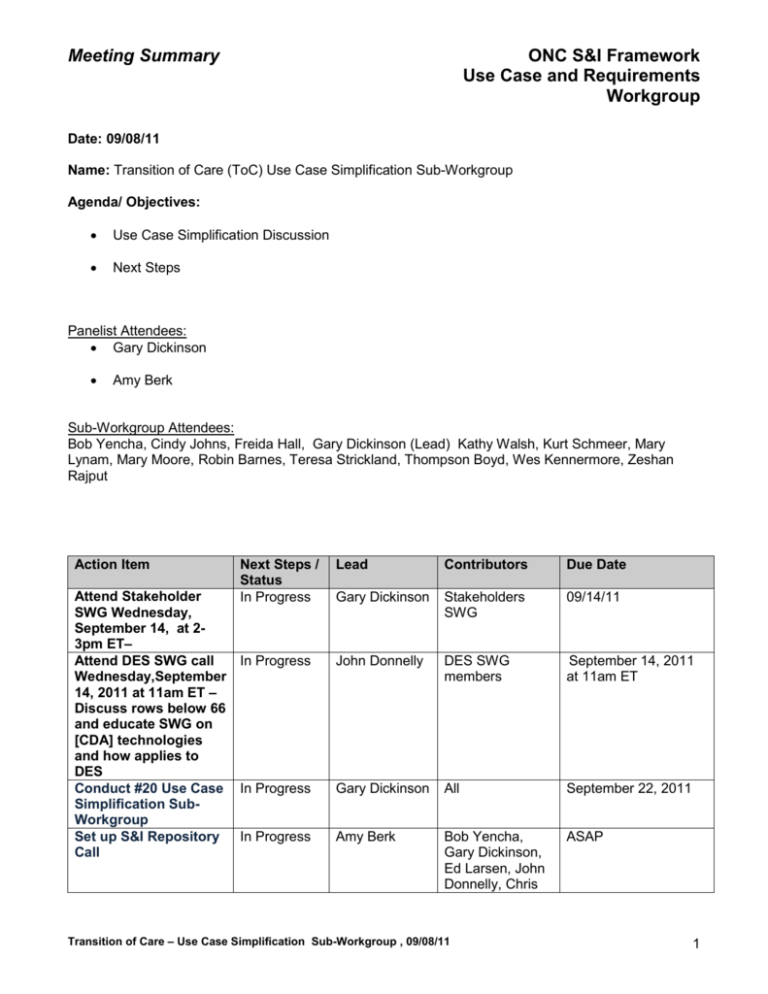
Meeting Summary ONC S&I Framework Use Case and Requirements Workgroup Date: 09/08/11 Name: Transition of Care (ToC) Use Case Simplification Sub-Workgroup Agenda/ Objectives: Use Case Simplification Discussion Next Steps Panelist Attendees: Gary Dickinson Amy Berk Sub-Workgroup Attendees: Bob Yencha, Cindy Johns, Freida Hall, Gary Dickinson (Lead) Kathy Walsh, Kurt Schmeer, Mary Lynam, Mary Moore, Robin Barnes, Teresa Strickland, Thompson Boyd, Wes Kennermore, Zeshan Rajput Action Item Next Steps / Status In Progress Attend Stakeholder SWG Wednesday, September 14, at 23pm ET– Attend DES SWG call In Progress Wednesday,September 14, 2011 at 11am ET – Discuss rows below 66 and educate SWG on [CDA] technologies and how applies to DES Conduct #20 Use Case In Progress Simplification SubWorkgroup Set up S&I Repository In Progress Call Lead Contributors Due Date Gary Dickinson Stakeholders SWG 09/14/11 John Donnelly DES SWG members September 14, 2011 at 11am ET Gary Dickinson All September 22, 2011 Amy Berk Bob Yencha, Gary Dickinson, Ed Larsen, John Donnelly, Chris ASAP Transition of Care – Use Case Simplification Sub-Workgroup , 09/08/11 1 Meeting Summary ONC S&I Framework Use Case and Requirements Workgroup A. Notes from Discussion: General Topics: The purpose of the Use Case Simplification Sub-Workgroup is a cross-cutting sub-workgroup open to all Use Case members, e.g.ToC and Lab Results Interface, to simplify the use case and requirements outline, template, and artifacts and make recommendations to all WGs and S&I Framework teams. A Co-Lead position is open if anyone is interested Presentations and Spreadsheets will be posted to the Wiki for review Use Case Simplification Discussion: AGENDA: 1) Welcome and Introductions 2) Report on DES Subgroup activities 3) Report on Stakeholder Subgroup activities 4) Review DRAFT Component Registration Requirements 5) Report on status of Component Registration in US Health Information Knowledgebase (USHIK) 6) Review DRAFT Use Case Development Tool Requirements 7) Discuss F2F meeting –October 18-19th, 2011 Washington, DC 8) Other business and discussion 9) Adjourn Report on DES Subgroup activities-cancelled this past week o DES WG continues to work on Master DES o Achieved consensus on everything down to row 63 o How do we achieve consensus on those items below row 66? Transition of Care – Use Case Simplification Sub-Workgroup , 09/08/11 2 Meeting Summary o o o o o o ONC S&I Framework Use Case and Requirements Workgroup Work at hand to drill down on items for LRI use cases; HL7 v2 method of exchange and then map to correlating CDA concepts or find gaps; all open items Effort focusing on “below the line” starting at row 66; DES for v1 go to row 63, and then additional data elements Will look at two new use cases and the DES coming out of those; Certificates and Provider Directories Will work with AHRQ to decide how to include the DES into the USHIK May cancel DES for next week due to HL7 ---need to look at v2 definitions and a lot of people will be at HL7 meeting Report on Stakeholders SWG o Narrow the scope to those actors in the Use Cases that we are currently working with; those actors in Column “B” on the Common actors tab; intent is to expand that to include the actors identified in the User Stories o Not going to tackle the broader set of Stakeholders o Input from Luann Whittenburg; gave us models; a way to view stakeholders and the various roles that stakeholders could have and also presented a stakeholder spreadsheet to include definitions o Need help with the definitions o In the process of going through a review of stakeholders as identified in the Use Cases; those as part of the core matrix o Bring forth all actors in the User Stories and then define them and then categorize them as organizations, individuals or systems Review DRAFT Component Registration Requirements o Forwarded set of documents to Mike F. ; have identified core components; requirements, actors, actions, DES and their elements (v1.0) o Now that we have consensus we want to register these components with USHIK o Forwarded the Core Matrix v1 and the DES v1 spreadsheet to Mike; include requirements to be considered for registration o Capture the components; requirements as a component and their details, common actors, common actions, common DES, and common data elements; as entries in USHIK and then be able to capture additional elements as core components and then be able to maintain version control of components and then be able to look up components o USHIK has begun the pilot of the components received o What specifications are there around the meta-data? USHIK will consider this later as a next step o Ultimate goal is to identify components for future use in Use Cases o Any data elements that can be reused can be linked to the Use case or other registered data o Identifying the various components that we would consider registering; core components, requirements (common actors-later), common actions and then common DES –registration of Transition of Care – Use Case Simplification Sub-Workgroup , 09/08/11 3 Meeting Summary o o o o o o o ONC S&I Framework Use Case and Requirements Workgroup each of those components and the detail associated with and standard references-cross mapping Mock up of the S&I portal in USHIK; and have loaded the draft data of DES; and will go forward with next steps Review in two weeks So far just looking at the data; but will most likely have questions on the meta-data As the artifacts evolve; they will evolve in USHIK as well HL7 is in place as well as the CDA (both in USHIK) –could link to CDA/CCD Link DES to C154? Is this of value? A question for the future? It would be valuable In those definitions, did you capture the xpat? Yes, we did, and so it would be very valuable and the CDA harmonization WG should review the xpat statements Review DRAFT Use Case Development Tool Requirements o Identify commonalities between the Use Cases and identify core components and then potential candidates for reuse going forward and now moving forward to the registration of the core components in the repository? o How can we best actualize the core components going forward? o UC development tool has been developed –are these requirements appropriate? And if not, how can they be so? How can we draw for core components? o How can we use the work completed so far going forward; from a reuse standpoint? o Set of requirements for the tool Identified the core components and achieved consensus Registered the core components into USHIK Row 5; identify the requirements that the tool would be able to address o How should we present and move forward? Start with Use Case instances Have four now and three others queing up Create and maintain these use case instances and then new use cases Allow the new components to be used Capture assumptions, pre-conditions, post-conditions Maintain one or more scenarios associated with each one Actions being taken; associated with the scenarios; within the scenario we have events, actors, etc Would want to be able to take and render the scenarios with the user stories and the requirements, process scope (actions), and the data scope (DES), and the actors--outputs from the tool o Now that we have identified these core components; we have a way to specify that these core components can be expressed in certain ways; the core components are now ready to use based on your specifications---ready to implement o Repository of core components; both with USHIK and the S&I Repository –Amy to set up a call with Chris o USHIK will be able to repurpose the core components –USHIK can do the testing and validation as well o USHIK-one stop shop for implementation ---Register, Access and additional capabilities for implementation ---Register, Load, Link Transition of Care – Use Case Simplification Sub-Workgroup , 09/08/11 4 Meeting Summary o o ONC S&I Framework Use Case and Requirements Workgroup Apply work of UC Simplification to QH –publish/subscribe pattern –can look at cardinality for other use cases (similar format as ToC) Pick one use case as a pilot; mock it up as a draft for USHIK F2F on Oct 18-19th; UC Simplification will be part of F2F Half day with two sessions; Introductory session and then second session to do some hands down work; topic just discussed; tooling, repository, etc ---Before Wednesday afternoon Next Steps: Defer to Action Item Table Above Transition of Care – Use Case Simplification Sub-Workgroup , 09/08/11 5
